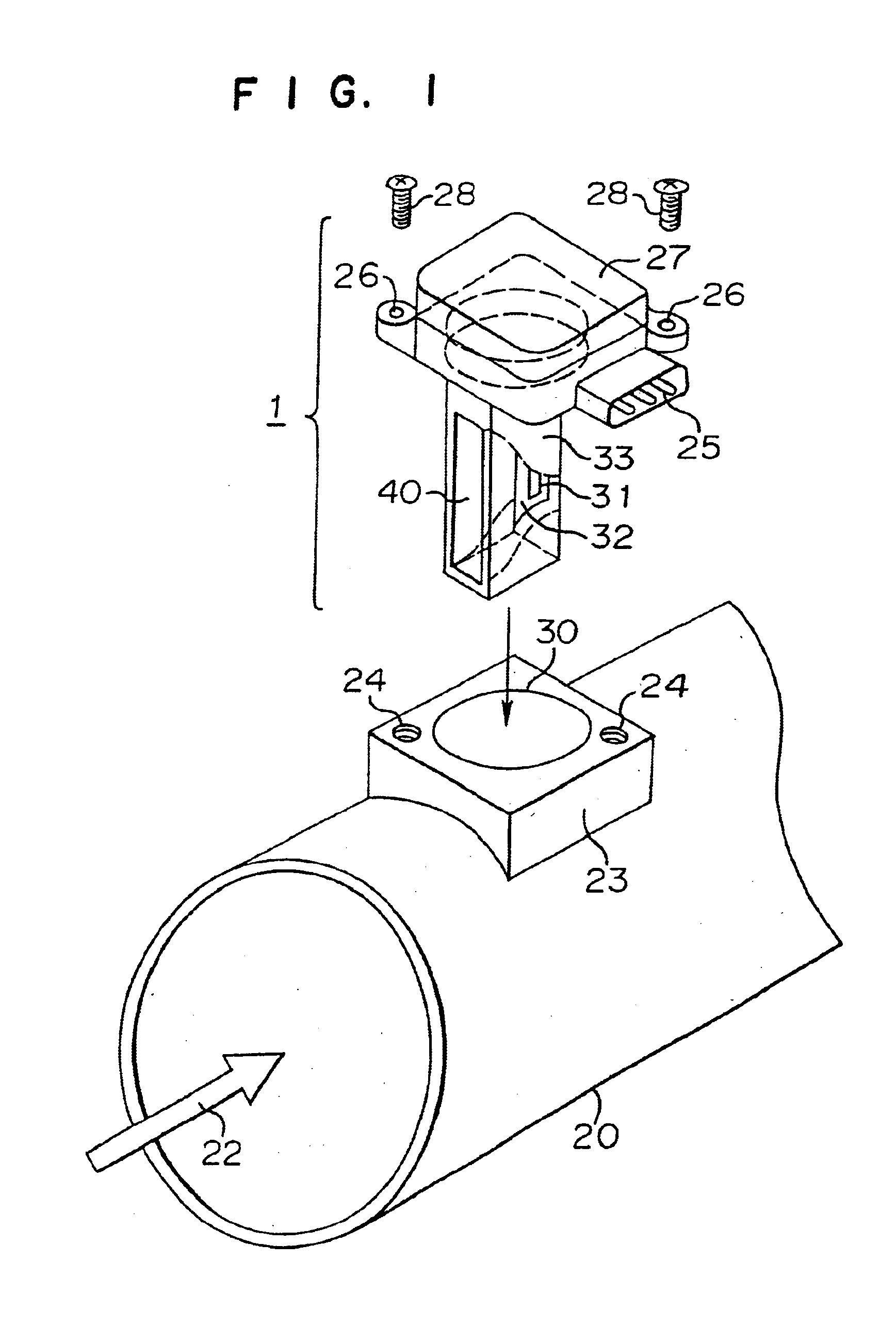Flow rate measuring device
a flow rate and measuring device technology, applied in the direction of instruments, electric control, combustion air/fuel air treatment, etc., can solve the problems of rate measuring device b>1/b> producing detection error to fail to optimize the control of air-fuel ratio, and swirling stream to provide more complicated streams. , to achieve the effect of stably introducing, better accuracy and better accuracy
- Summary
- Abstract
- Description
- Claims
- Application Information
AI Technical Summary
Benefits of technology
Problems solved by technology
Method used
Image
Examples
embodiment 1
In FIG. 1 is shown a perspective view of the flow rate measuring device according to a first embodiment of the present invention. In this FIG., reference numeral 1 designates the flow rate measuring device, reference numeral 20 designates an induction pipe, reference numeral 22 designates an arrow to indicate the forward direction of intake air, reference numeral 23 designates a seat to mount the flow rate measuring device 1 to the induction pipe 20 by insertion, reference numerals 24 and 26 designate threaded holes to fixedly mount the flow rate measuring device 1 to the seat 23, reference numeral 28 designates bolts, reference numeral 25 designates a terminal for connection of signal lines, reference numeral 27 designates a cover for covering an electronic circuit board (not shown) arranged therein, reference numeral 30 designates an opening formed in the seat 23 and in a side wall of the induction pipe 20 for inserting the flow rate measuring device 1 into the induction pipe 20, ...
embodiment 2
In FIG. 20 is shown a front view of the flow rate measuring device according to a second embodiment of the present invention. In this FIG., reference numeral 46 designates one of opposite tapered walls. In this embodiment, the measuring duct 40 has the length in the transverse direction of the elongated introduction port or short sides gradually shortened toward the downstream direction between the introduction port 41 and the exit port 42 as in the length of the introduction port in the longitudinal direction. In other words, the transverse cross-sectional shape of the measuring duct 40 perpendicular to the flow is gradually shortened toward the downstream direction in terms of the length in the transverse direction as well in comparison with the mode of the first embodiment shown in FIG. 6(b).
Now, the operation will be explained. The explanation will be made, comparing this embodiment with the first embodiment for easy comprehension of the operation. In FIG. 21 is shown a schemati...
embodiment 3
A third embodiment provides an arrangement to stabilize streams in the measuring duct and further reduce an error in flow rate detection in a constant flow and a pulsating flow. In FIG. 23 is shown a perspective view of the flow rate measuring device according to the third embodiment. In this FIG., reference numeral 56 designates notches, which are formed in side walls of the post 33 at the downstream end of the measuring duct.
Now, this embodiment will be explained in comparison with the absence of the notches.56 for easy comprehension of the operation in the provision of the notches 56. In FIG. 24 is shown a schematic view to explain how streams flow in the provision of the notches. In FIG. 25 is shown a schematic view to explain how streams flow in the absence of the notches. In both FIGS., the post is shown to be cut in the transverse direction along the flow direction.
When the notches 56 are not provided, that is to say, when streams 34 and 36 join at the tails of two flat plate...
PUM
 Login to View More
Login to View More Abstract
Description
Claims
Application Information
 Login to View More
Login to View More - R&D
- Intellectual Property
- Life Sciences
- Materials
- Tech Scout
- Unparalleled Data Quality
- Higher Quality Content
- 60% Fewer Hallucinations
Browse by: Latest US Patents, China's latest patents, Technical Efficacy Thesaurus, Application Domain, Technology Topic, Popular Technical Reports.
© 2025 PatSnap. All rights reserved.Legal|Privacy policy|Modern Slavery Act Transparency Statement|Sitemap|About US| Contact US: help@patsnap.com



